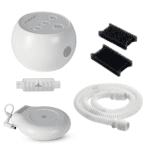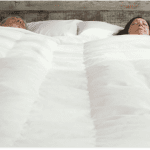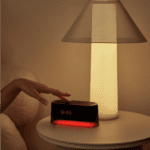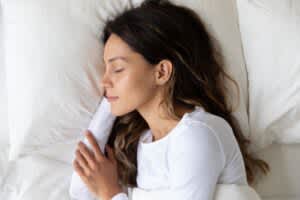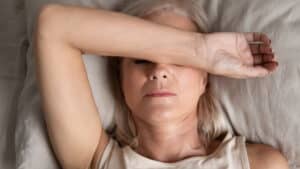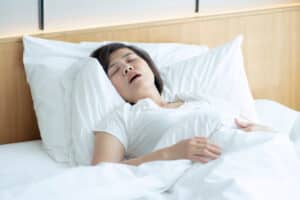Women have distinctive sleep needs and patterns that can change throughout their lifetimes. The quality and quantity of their sleep can be influenced by hormones, health conditions, and gendered roles within their family or community. According to research, although women tend to get slightly more sleep than men, they are less likely to get good quality sleep.
Hormonal changes due to menstrual cycles, pregnancy, and menopause can affect sleep patterns and increase the risk of certain sleep problems. When women have sleep problems, they present symptoms differently than men typically do and are less likely to be referred for diagnostic testing of certain sleep disorders.
Understanding the conditions unique to women and people assigned female at birth can help identify and manage sleep problems and improve the quality of sleep.
How Much Sleep Do Women Need?
In general, adults of any gender need between seven and nine hours of sleep a night to feel refreshed.
The amount of sleep women need can depend on their age, whether they are pregnant, and other factors related to their health. For example, pregnant people may need more sleep and those who are older and postmenopausal tend to get less.
Sleep Challenges Unique to Women
Sleep behaviors and sleep problems are related to qualities that are specific to a person’s sex and gender. Sex refers to biological characteristics that include internal and external reproductive organs, hormones, and chromosomes. Gender refers to the roles, identities, and behaviors that a culture assigns to women, men, and nonbinary people.
Women and people who are assigned female at birth have a unique hormone profile that can influence sleep patterns throughout their lifetime. Hormone production changes during puberty and continues to fluctuate monthly until menopause, when new changes occur. During each phase of life, hormonal changes can lead to disruptions in sleep quantity and quality.
Gendered roles within a person’s family or community may also play a role in the differences between how men and women sleep. Women are more likely to serve as caregivers and take on additional household responsibilities, which some researchers suggest can disrupt their ability to get quality, uninterrupted sleep.
Effect of Menstrual Cycle on Sleep
The menstrual cycle is linked to changes in circadian rhythms, including the sleep-wake cycle that determines when a person feels sleepy or alert. One-third of people report sleep disturbances in the week leading up to their menstrual cycle or during their cycle.
For about a week leading up to and during menstruation, people can experience symptoms that make it difficult to fall asleep and stay asleep throughout the night. Changes in progesterone and estrogen levels can cause cramps, bloating, and headaches. People who menstruate are also more likely to experience disruptive nighttime wakings and vivid dreams during this time.

Pregnancy and Sleep
Pregnancy can bring about many changes to a person’s body and routine, including their sleep habits and patterns. Pregnant people tend to have poor quality of sleep and a decrease in the total amount of sleep time. During the three trimesters of pregnancy and after delivery, they experience symptoms that may make sleep difficult.
- First and Second Trimesters: An increase in the level of progesterone can affect the quality of sleep. During this time, many report feeling tired during the day and an urge to get more sleep.
- Third Trimester: Sleep quality may be even worse in the later weeks of pregnancy. There is a decrease in the amount of deep sleep and in rapid eye movement (REM) sleep. Uncomfortable pregnancy symptoms, such as heartburn, the baby’s movements, and the need to urinate during the night, can also lead to poor sleep.
- After Giving Birth: Sleep deprivation is common for new parents as they adjust to the baby’s eating and sleeping schedule. The lack of sleep can lead to postpartum depression, so it’s important to try to get as much sleep as possible.
How a Woman's Sleep Changes With Age
Women and people who menstruate go through several hormonal phases throughout their lifetime. Both sleep quantity and sleep quality change with age. Younger women typically experience the highest quality sleep and older women tend to sleep less hours per night.
Certain sleep issues coincide with the hormonal changes that occur as a person’s reproductive years come to an end.
- Perimenopause: This transitional stage occurs at the end of a person’s reproductive years. It is characterized by irregular menstruation, hot flashes, and hormone changes. During perimenopause, women tend to sleep less than seven hours.
- Menopause: People who menstruate typically experience menopause by the age of 55. Sleep can be disrupted by night sweats, headaches, hot flashes, and heart palpitations, which are all common symptoms of menopause. At this age, there is also an increased risk of sleep disorders, including sleep apnea and restless legs syndrome (RLS).
- Postmenopause: The lack of progesterone in postmenopausal people is associated with an increased risk of obstructive sleep apnea. At this point in their lives, they may have trouble falling asleep and staying asleep, and may not wake up feeling well rested.
Sleep Problems More Common in Women
Some sleep problems are more common in women, and women tend to report different symptoms of sleep disorders than men typically do.
Women have more trouble falling asleep and are more likely to take medication to fall or stay asleep. Women are also more likely to have sleeping disorders associated with daytime sleepiness, a condition which can have a significant impact on their quality of life.
In a study comparing how men and women reported their sleep problems to a health care provider, it was found certain symptoms were more common among women, including:
- Depression
- Difficulty with concentration and memory
- Relationship issues
Insomnia and Mood Disorders
About one-quarter of women experience insomnia. The risk of insomnia increases after menopause, possibly due to changes in hormones and other factors associated with aging. Insomnia can affect a person’s quality of life, with many reporting symptoms like daytime sleepiness, difficulty performing day-to-day tasks, and changes in mood.
Insomnia is closely linked with mood disorders like depression, which tends to affect women more often than men. In many instances, it can be hard to tell whether one condition precedes the other, as people are likely to experience insomnia and depression at the same time.
Treatment is available for both insomnia and depression, and successful management of one condition usually helps to improve the other.
Pain-Related Sleep Problems
There is a strong correlation between poor sleep and chronic pain. Fibromyalgia is a chronic pain condition that is more common among women, affecting about 7% of those over the age of 60. People with fibromyalgia commonly experience fatigue and poor quality sleep.
Other health conditions that cause pain may also lead to sleep disturbances for women. For example, the aches and discomfort that persist during pregnancy can prevent a good night’s sleep.
Many women who have sleeping disorders also experience:
- Back pain
- Joint pain
- Chest pain
- Headache
Restless Legs Syndrome
Restless legs syndrome (RLS) is more common among pregnant people than other adults. RLS is a type of sleep-related movement disorder in which a person has the urge to move their legs during sleep or other times of rest. Symptoms of RLS may get worse over the course of a person’s pregnancy, but usually disappear after delivery.
Obstructive Sleep Apnea
Obstructive sleep apnea (OSA) is a sleep disorder in which a person’s breathing is disrupted while they are asleep due to brief but repeated airway collapse. OSA occurs when the tissue in the throat or back of the mouth relaxes during sleep and blocks the airway.
Overall, OSA is less common among women than men. While this decreased risk may be due to differences in male and female anatomy, some experts suggest that gender biases may also play a role in why women are less likely to be diagnosed with sleep apnea.
- Anatomical Risk Factors: The risk of OSA increases when the airway narrows, which may be associated with more fat in the neck, an issue that affects more males than females. However, a number of changes occur during pregnancy that can increase OSA risk, including a narrowing of the nasal passages and throat.
- Presentation of Symptoms: Women are more likely to describe symptoms like fatigue, feelings of depression, and insomnia. Men or their bedpartners are more likely to report symptoms like snoring and gasping for air during sleep.
- Diagnostic Tests: Some screening tests for OSA were developed based on how men experience sleep and sleep problems, so they may not be able to detect the presence of certain symptoms in women. In addition, women are less likely to be referred to sleep studies for OSA potentially due to the differences in symptom presentation.
Impact of Disrupted Sleep
Women who suffer from sleep deprivation face many changes in their health. In particular, older women who sleep less than seven hours a night experience difficulty with daily activities, affecting their overall quality of life.
Sleep disorders may become chronic conditions and can cause or worsen other health problems. Lack of sleep increases the risk of many diseases.
- Diabetes: Without enough sleep, the body cannot properly regulate blood sugar.
- Heart Disease: Lack of sleep causes high blood pressure and inflammation, which can damage the heart.
- Infection: Sleep keeps the immune system strong and helps ward off colds and other illnesses.
- Mental Health: Sleepless nights can make depression and anxiety worse.
Tips for a Better Night's Sleep
It is important that women get enough sleep on a regular basis and reduce stress as much as possible. For women going through various life changes, there are specific strategies for improving sleep.
- Pregnancy: Avoid heavy, spicy foods and caffeine before bedtime. It may also be more comfortable to sleep on your left side, with one pillow at your back, one pillow between your legs, and one pillow to rest your arms on.
- Menopause: To alleviate hot flashes that may disrupt sleep, try keeping the bedroom temperature cool, and use fans and light bedding for extra coolness. Avoid taking a hot shower or bath leading up to bedtime.
- Childbirth: Try to nap when the baby is napping, and seek help for nighttime feedings. It may also help to maintain a consistent routine for both you and your baby.
Getting a good night’s sleep is an important factor for maintaining overall health, and there are things people can do on a regular basis to improve their sleep hygiene and get a better night’s sleep.
- Maintain a Consistent Routine: Go to bed and wake up at the same time every day, even on weekends.
- Make Your Bedroom Comfortable: Make sure the bedroom is quiet, dark, soothing, and set to a comfortable temperature.
- Unplug Your Devices: Do not use TVs, phones, or computers in the bedroom.
- Be Mindful of Your Diet: Limit large meals, alcohol, and caffeine before bedtime.
- Get Physical: Getting some exercise during the day can make it easier to fall asleep at night.
When to Talk to a Doctor
Each stage of a woman’s life, from childhood to menopause, brings unique sleep challenges that may need tailored treatment.
If you continue to feel tired during the day or lack of sleep makes it hard to perform your daily activities, talk to your doctor or a sleep specialist. They will evaluate your symptoms and may suggest that you keep a diary to track your sleep habits. Additional testing or follow-up care may be offered to help you improve the quantity and quality of your sleep.
References
The Sleep Doctor Forum: Real Experiences, Real Connections
Continue the discussion on the Sleep Doctor Forum. Connect with experts and fellow forum members on CPAP, sleep apnea, and all things sleep. A priceless resource that’s free to join.


